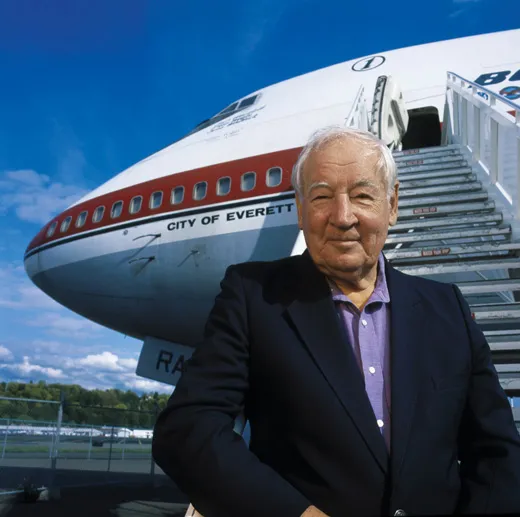The “Father of the 747”
Joe Sutter talks about the famed airliner’s birth
/https://tf-cmsv2-smithsonianmag-media.s3.amazonaws.com/filer/sutter-631-jan07.jpg)
Seattle native Joe Sutter is best known for leading Boeing’s 4,500-member design team for the 747, the largest commercial airliner ever built. After serving in the U.S. Navy on a destroyer escort in World War II, he went to work for Boeing in 1946, retiring after 40 years. Sutter, who was awarded the National Medal of Technology by President Ronald Reagan in 1985, is now a speaker and author of 747: Creating the World’s First Jumbo Jet and Other Adventures from a Life in Aviation (Associate Editor Bettina Chavanne in August 2006.
A&S: What influenced or shaped the way you designed aircraft?
Sutter: The airplanes I observed [as a boy growing up near the Boeing plant] made me determined to give an airplane the ability to survive bad circumstances. Everything won’t be great all the time. That’s why [the 747 has] four flight control systems, four hydraulic systems, four landing gears. You know things are going to happen, and sometimes it’s going to be severe. You still should be able to come home.
A&S: How did that help you design the Boeing 747?
Sutter: At the start of a program, asking questions is the most important part of the process. If you get [the customer’s] requirements wrong, then you don’t have a successful product. In the case of the 747, we listened very hard to Pan Am Chairman Juan Trippe and the other airlines, and looked to the future. One of the decisions we made was to be a good freighter as well as a good passenger plane. That was probably one of the most important decisions we made, because it influenced [the size of the] fuselage. It’s how the wide-body concept came into being.
A&S: Had you gone to work for Douglas Aircraft, which offered you a job after the war, would we instead be flying in a Douglas 747?
Sutter: That’s a question I’ve been asked and wondered about. I think what’s more important is the reason for the 747: Trippe and Bill Allen [Boeing’s president from 1945-68]…. People that study the hell out of a problem, like they do now, would have determined the 747 wasn’t worth the effort. It required Trippe’s and Allen’s vision. If they hadn’t been in place, the 747 wouldn’t have happened. Then you wonder, what would the industry look like today without it?
A&S: How is designing an aircraft for an airline different than designing one for the military?
Sutter: On a commercial plane, the specifications between Boeing and the customer are 50 pages, whereas for the military, it’s thousands of documents. With military aircraft, there’s a tremendous amount of overhead that doesn’t add anything to the process or the project. With commercial aircraft, it’s a much more direct effort. The airline buys an airplane to do a certain job, and the company has to build an airplane to make that commitment and then get it certified. It’s a more direct approach.
A&S: For years, Douglas and Boeing were locked in a tight technological race that Boeing eventually won. What was the determining factor?
Sutter: Boeing has always had people at the top that were inclined toward the future and had the ability to convince management to spend money on the future. After the war, they were building B-17s and B-29s, whereas Douglas had been building transports during the war. But Boeing saw that people wanted more efficient, faster airplanes…. Boeing saw that the combination of a swept-wing and jet engine was the future of aviation. They built their own prototype and decided, "Let’s get into the business. We’re going to have a whole family of planes to cover long-range and domestic." They never took their eye off the ball. … Douglas kept looking at the fact that military contracts are reliable—government money. Commercial airplanes are your own money. That made Douglas shy away from risky investment in commercial planes.
Looking at it, no one in his right mind would want to get into this business. When you make the commitment, you’re stuck with it. You don’t start getting your money back for at least five years, so you bet the company each time you do a new project. Boeing has that culture, which comes from way back. It’s stayed with them since then.
